

William Stopford
Every car discontinued in Australia in 2025
1 Day Ago
The recipe is simple: take a sexy coupe, kill the hybrid option, and drop the top. The result is every bit as delicious as you'd expect.
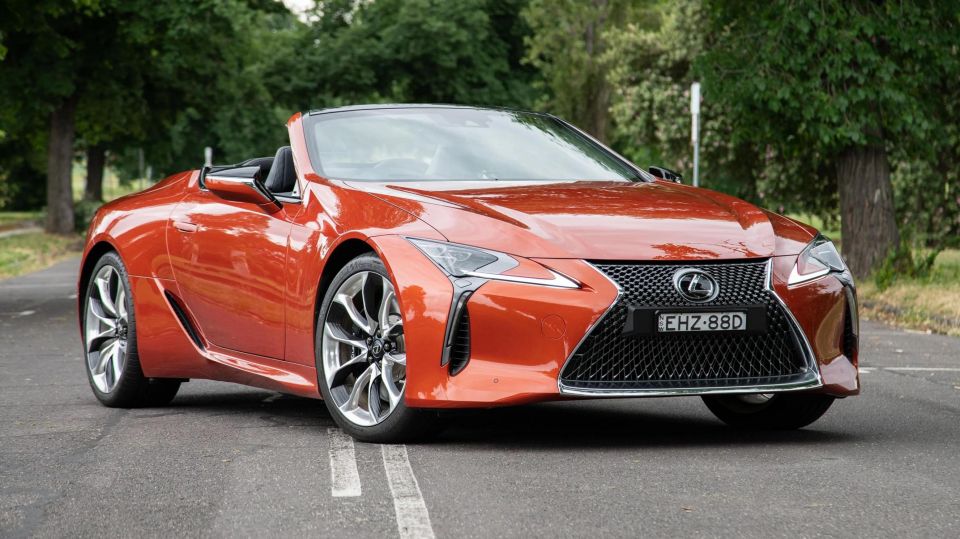
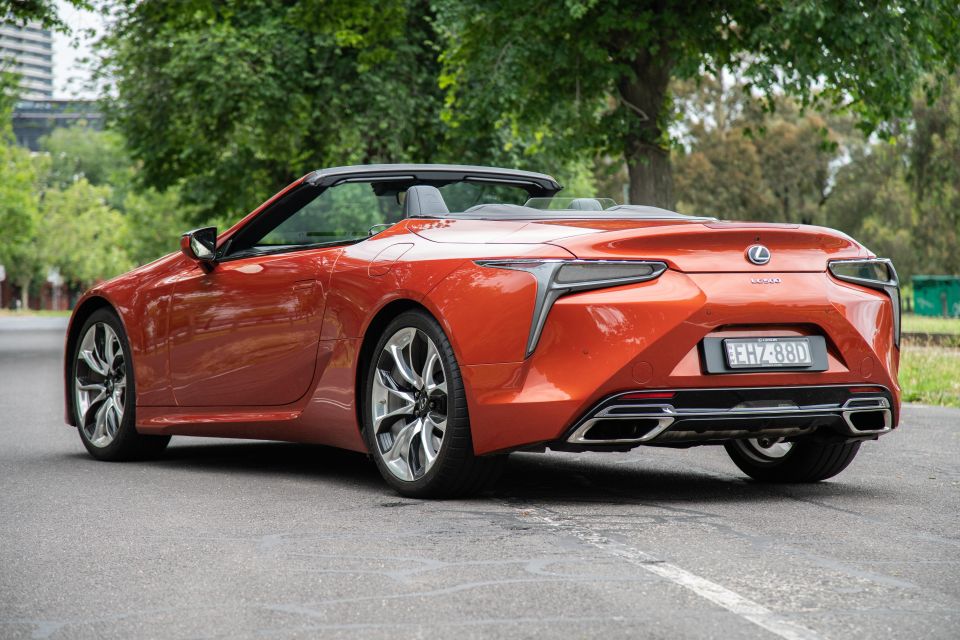

Contributor
New from
$193,925
excl. on-roads

Contributor
New from
$193,925
excl. on-roads


Contributor
New from
$193,925
excl. on-roads

Contributor
New from
$193,925
excl. on-roads
Quickly see how this car stacks up against its competition. Select any benchmark to see more details.
Where expert car reviews meet expert car buying – CarExpert gives you trusted advice, personalised service and real savings on your next new car.
I’ve only had the LexusLC500 Convertible for 15 minutes when the attention starts.
Sun shining, roof down, music blasting, I’m crawling through a skinny side street when a kid, maybe five years old, sprints out of a shop onto the footpath and yells “rev it!” through missing front teeth.
It’d be rude not to – and it’s what six year-old Scott would have wanted – so that’s exactly what I do. The LC500 snarls and smacks into the redline in neutral, sound echoing off the surrounding parked cars and apartment blocks.
The kid grins and covers his ears, before running back inside to tell his parents. Whoever said kids don’t like cars anymore clearly hasn’t met this one.
It’s that kind of car, the LC500 Convertible. Kids smile and adults crane their necks for a closer look. Forget concept looks, it’s part car and part spaceship that just happens to sound like Tom Jones making love to a NASCAR.
But it’s not a fragile supercar that needs to be coddled. It’s an ultra-capable, ultra-appealing grand tourer with the substance to back up its seriously sexy exterior.

Pricing for the LC500 Convertible starts at $214,000 before on-road costs, or $19,253 more than the LC500 coupe.
Once you bundle in the Enhancement Pack on the coupe – which you should, because what’s the point of a flagship if you’re aren’t going to dress it up – that price gap drops to just $4253, making the drop-top a pretty enticing option.
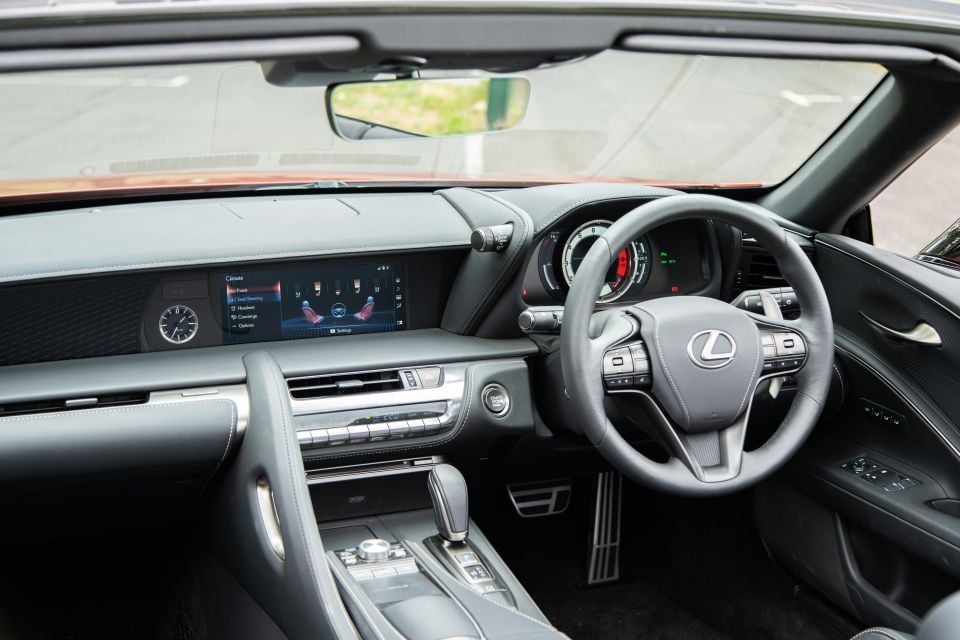
It’s tough to find a pure competitor for the LC500. BMW has the M850i Convertible from $289,900 before on-roads, but it’s not quite on the same level as the Lexus when it comes to traffic-stopping, neck-snapping presence.
The timeless Porsche 911 Cabriolet could also be considered a rival, given it’s a four-seater drop-top with a performance bent, but even the least expensive Carrera 2 starts at $258,600 before on-roads.
In the world of eye-catching drop-tops, you really need to stretch to something like the Aston Martin DB11 Volante with its $398,495 price tag to match the big Lexus for sex appeal.
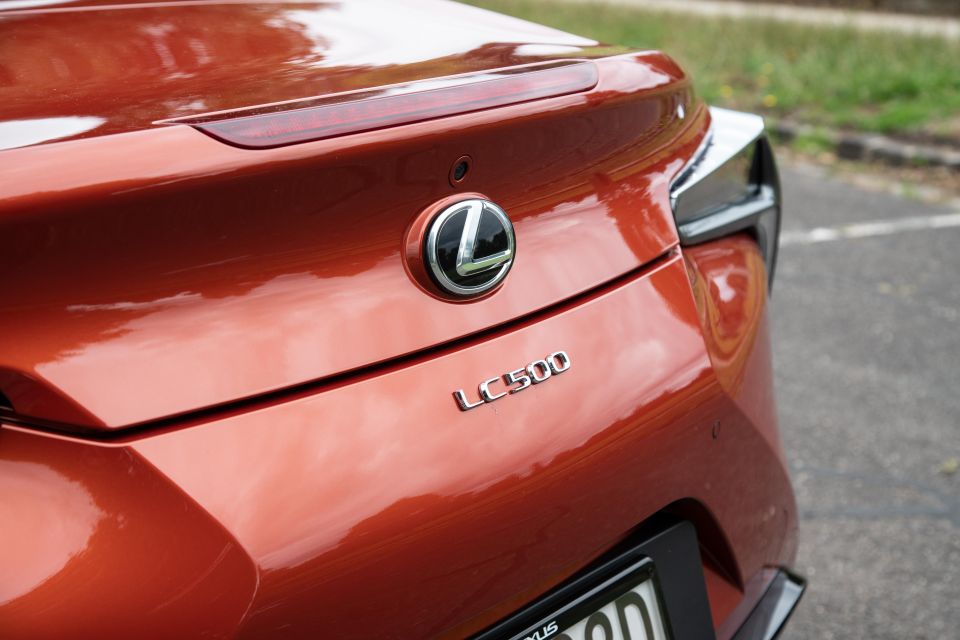
Buy your new car without the stress. It's fast, simple and completely free.

Great service from Travis and team, second time I have used this business would not hesitate to recommend them to anyone
Craig C.
Purchased a Ford Ranger in Sunshine Coast, QLD
CarExpert helped Craig save thousands on his Ford Ranger, now let us save you on your next new car.
Find a dealLexus trades on its well-trimmed, well-equipped cars, and that theory extends to its two-door flagship.
Externally, the car rides on dished 21-inch alloy wheels that would look more at home on the motor show stand than a supermarket carpark, and lighting at both ends is LED.
Entry is keyless, and the door handles are Aston Martin-style flush-fitting units that present themselves when the car is unlocked and fold away once you’re moving. It seems like Lexus has made them quieter with its recent update to the LC, although it’s not mentioned in any of the official materials.
Inside, the driver and passenger sit in powered, heated, and cooled sports seats trimmed in semi-aniline leather, and the thick steering wheel is heated to boot. It’s also electrically adjusted, and retracts when the car turns off for a smoother, more graceful exit.
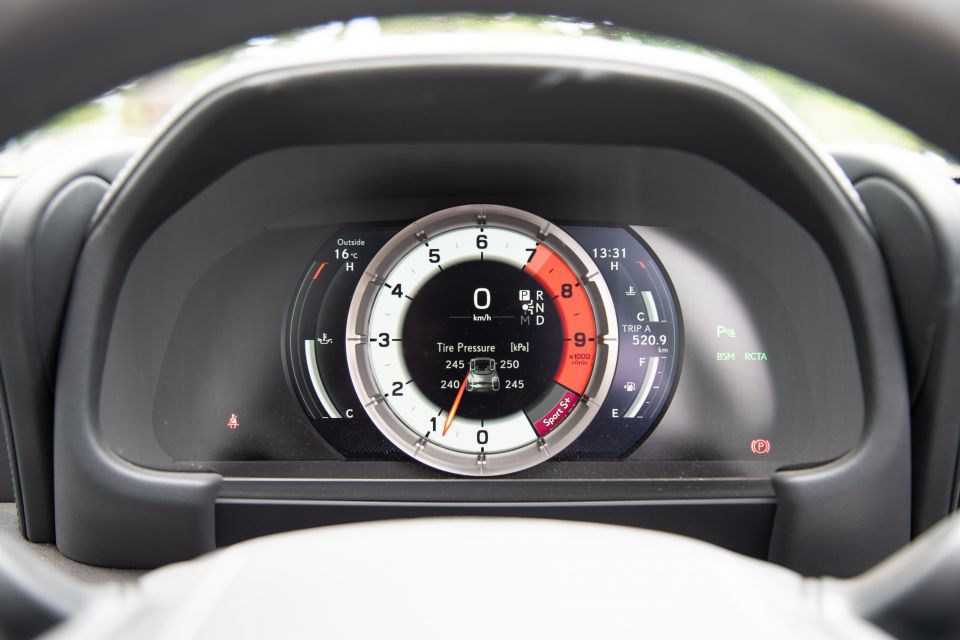
Facing the driver is an 8.0-inch digital instrument binnacle featuring the effortlessly cool sliding tachometer ring from the LFA supercar and a coloured head-up display, while the central infotainment display is a 10.3-inch unit controlled by a touchpad that’s equal parts unintuitive and distracting.
Along with factory satellite navigation, it now features wired Apple CarPlay and Android Auto. If you get tired of the sonorous V8 engine, there’s a 13-speaker/918W Mark Levinson sound system.
As you’d expect, the headlights and wipers are automatically operated, the rear-view mirrors dim automatically, and there’s dual-zone climate control.
Although there are front and rear parking sensors, you don’t get a surround-view camera to protect the nose. Instead, there’s a rear-view camera that feels more ES hire car than sexy supercar.
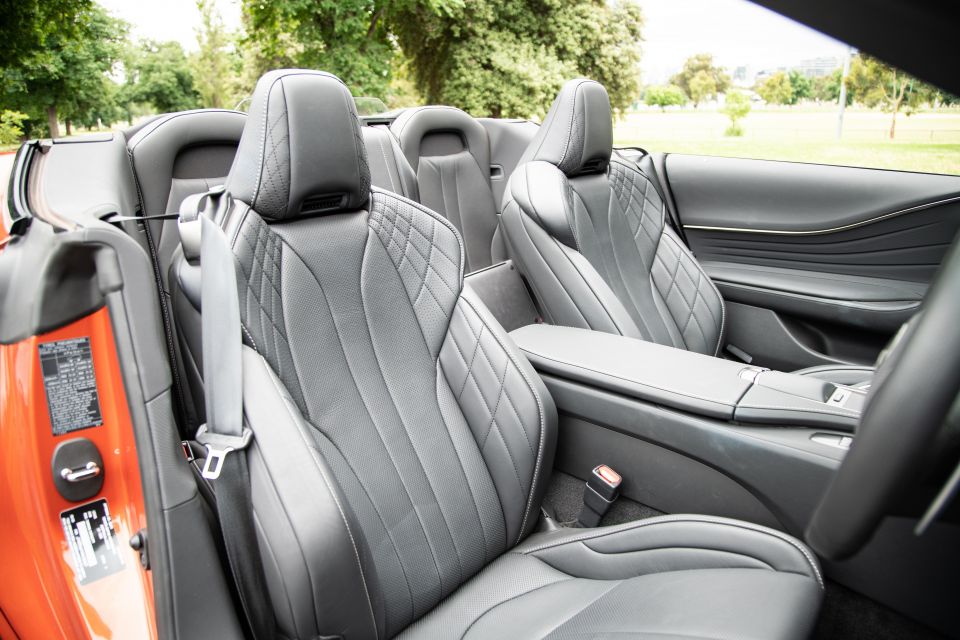
As is often the case with sports cars, the LC500 hasn’t been crash tested by ANCAP or Euro NCAP.
However, standard safety kit includes six airbags and the following suite of active safety assists:
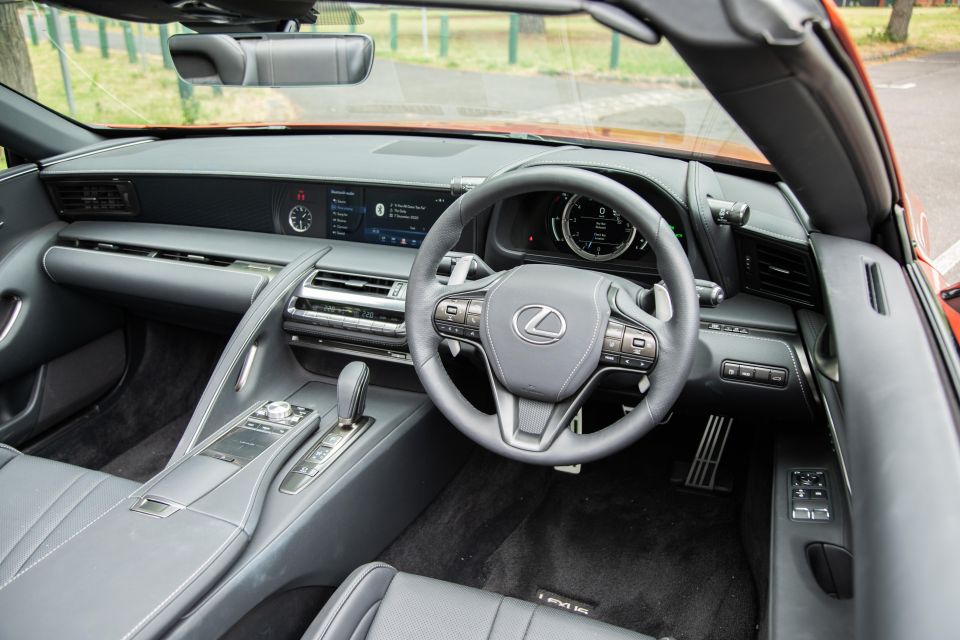
Like the coupe, the LC500 Convertible is beautifully screwed together inside.
The seats in particular are excellent, with just the right amount of bolstering and support for long trips. They’re trimmed in supple leather, and can accomodate even the lankiest frames. They’re also heated and cooled, and will blow hot air on your neck.
You’re cradled low in the car, enveloped by the rising door trims and hugged by the soft but supportive seats. Comfortable? It is, but it’s also purposeful.
The driver is faced with the achingly cool LFA-style digital instrument cluster, with a sliding metal ring framing a digital rev counter that changes based on your drive mode.
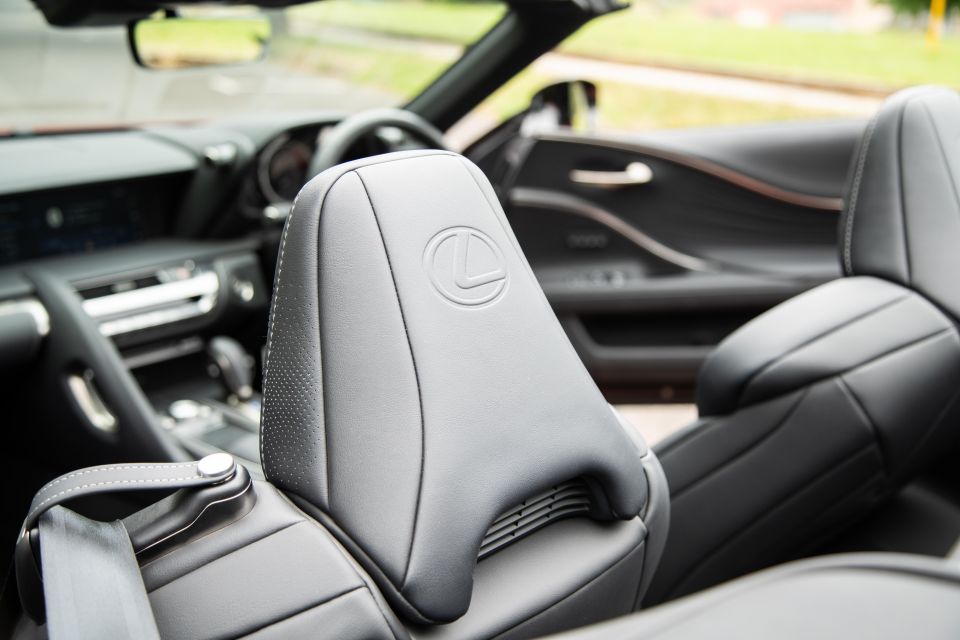
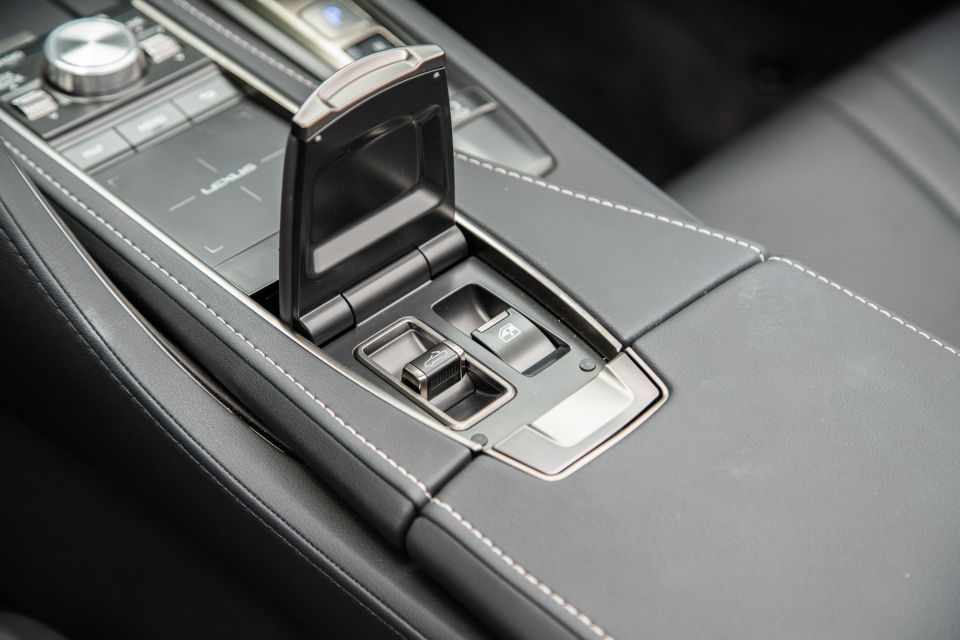
Sure, it doesn’t do quite as much as the screen in the latest Audi or Mercedes-AMG cars, but it’s crystal clear and looks so much cooler.
Taking pride of place in the centre of the dashboard is a 10.3-inch display, sat next to a simple analogue clock and gallery-style trim flowing into the passenger’s door.
Unfortunately, not even the flagship LC500 is safe from the infuriating Lexus infotainment touchpad. It’s maddening to use on the move; sometimes it jumps at light speed across the screen when you gently flex your wrist, others it feels like the cursor is stuck.
It’s not just radio, media, and navigation function that are held tight within its clutches, even your heated seats and minor climate controls are buried in sub-menus. Thank god Lexus has finally dropped in Apple CarPlay, which papers over some of the cracks.

Technical grumbles aside, the LC500 is just a beautiful place to spend time. The design is stunning, from the sweep of the dashboard to the way the passenger grab handle flows from the centre console to the transmission tunnel, and the materials are suitably expensive.
Even the sliding, pivoting central armrest has a beautifully damped action, and the flip-up cover for the roof controls shuts with a satisfying snap.
Build quality is bank vault good, with no squeaks or rattles on rough roads, and the Mark Levinson stereo has more than enough punch to play over the wind at 100km/h.
Although it’s billed as a two-plus-two with part-time rear seats, the only real use for them is a place to slot a few soft bags, or a spot for your golf bag. Given the boot is absolutely tiny, with just 149L of space, people who can’t pack light will be giving the rear pews plenty of use.
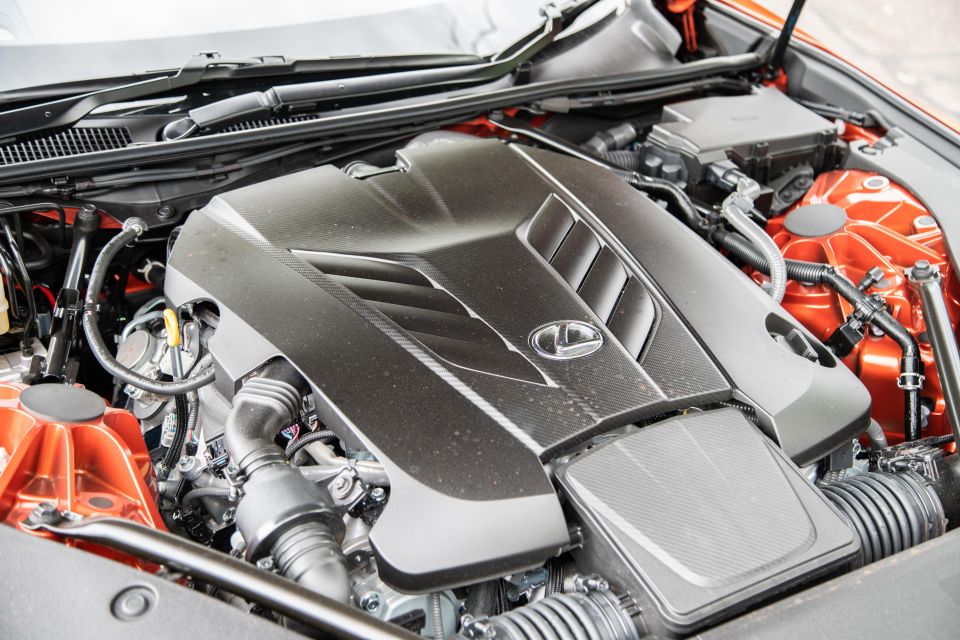
Boring old Lexus isn’t so boring anymore. It’s still the king of hybrid sedans for airport transfer drivers and the undisputed champion of the golf club carpark, but it’s also keeping the naturally-aspirated V8 engine alive.
The engine in the LC500 is a masterpiece. It’s a high-revving Yamaha throwback that’s equal parts orchestral and intoxicating, and makes the latest (faster, more efficient) turbo’d engines from BMW, Audi, and Mercedes-AMG look a bit contrived.
It pumps out 351kW of power at 7100rpm and 540Nm of torque at 4800rpm, with power sent to the wheels through a 10-speed automatic transmission with paddle shifters.
Claimed fuel consumption is 12.7L/100km. Although a more efficient hybrid option is available in the coupe, the LC500 Convertible is only offered with the V8.
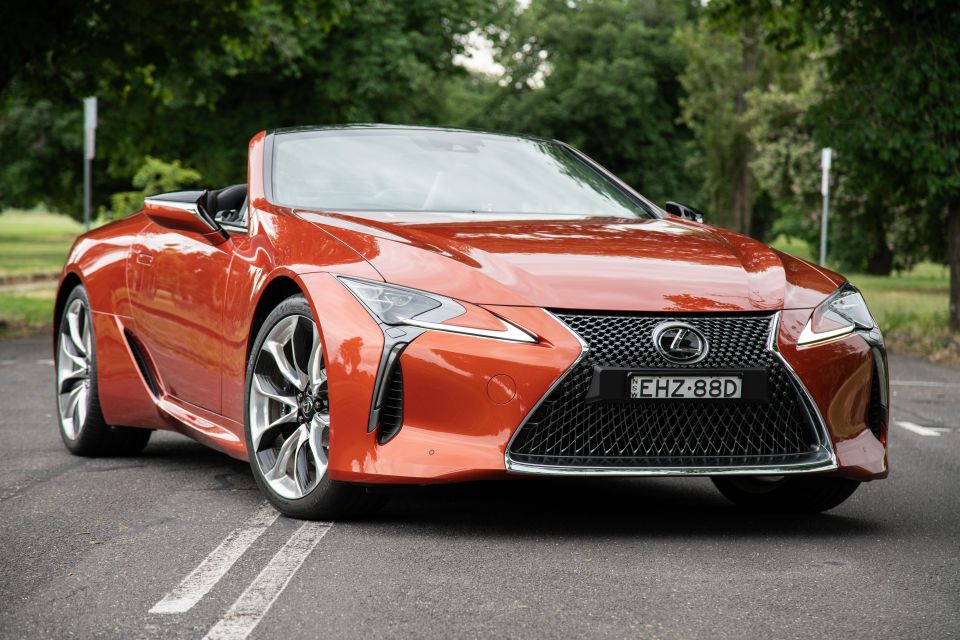
The LC500 is dominated by the high-revving masterpiece under the bonnet. It bursts into life with a snarl, and settles into a slightly frenetic idle. Although it’s a big displacement bent-eight, there’s nothing lazy about the engine in the LC.
The way it delivers its performance is totally different to most modern turbocharged engines, because it doesn’t just hit peak torque and stay there. Instead it builds through the rev range, gathering pace steadily from idle until about 4500rpm, at which point the noise hardens and the rev needle attacks the limiter with even more vigour.
While we’re talking noise, the LC500 is arguably the best sounding car on sale in Australia today. It starts off with a bassy, gravelly growl at low revs, but the noise hardens and gets higher in pitch as the needle swings around, building to a brassy crescendo that feels more motorsport than lazy, relaxed grand tourer.
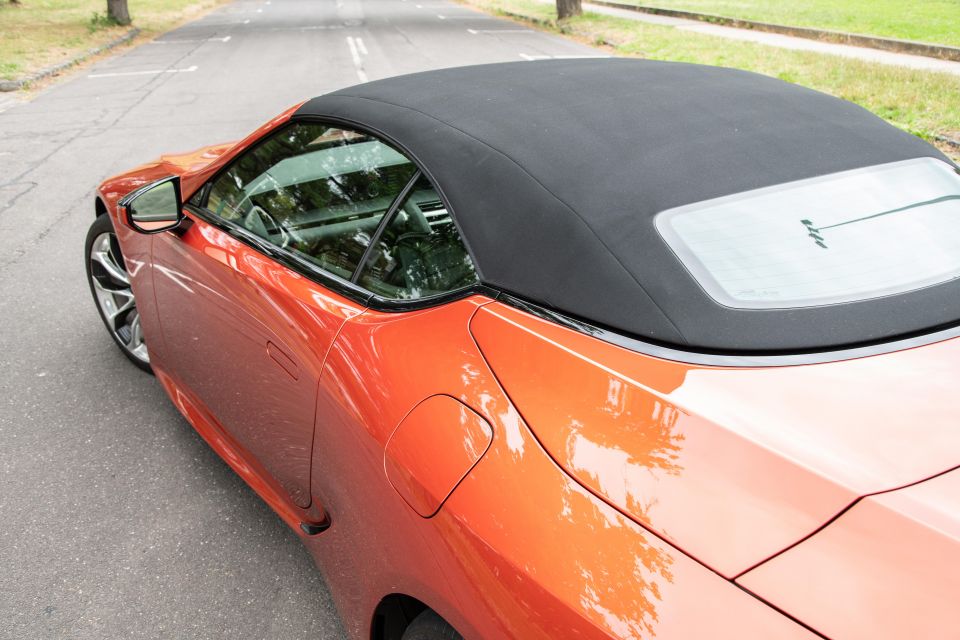
It’s utterly intoxicating, and never failed to make passengers and passers-by smile. It also goes to show you don’t need to engineer in any snap, crackle, and pop on the overrun to make a car sound special when you strip out the turbochargers.
Sonic theatrics aside the Yamaha V8 packs enough of a punch for fast progress, even if doesn’t have the any gear, any speed, any time shove of a European turbocharged V8. But the fact you need to work harder to get a move on is an integral part of its character, not a flaw, and the 10-speed automatic is quick enough to find the right ratio for moment most of the time.
Compared to the last LC500 we drove the transmission feels slightly quicker to shift, and is better at downshifting at lower speeds.
Whatever Lexus has tweaked has worked, because you can better enjoy the way the revs spike as you snap down the gears on the way into traffic lights or roundabouts… which is a long way of saying it’s better at being antisocial.

Of course there’s more to the big Lexus than just an engine. It’s a brilliant grand tourer, capable of eating up highway miles without breaking a sweat.
For starters, the ride is excellent for a car riding on 21-inch alloy wheels wrapped in liquorice strip tyres. It has suspension travel to deal with speed bumps and imperfect country roads, although it will occasionally thud into bigger potholes by virtue of the sheer amount of wheel that needs to be controlled.
It handles, too, albeit in the context of a two-tonne grand tourer. The steering is quick off centre and there’s a surprising amount of traction on the front axle, so you can really lean on it on the way into a corner and then get on the power early and enjoy what’s a balanced, well sorted chassis.
Get on the power early at lower speeds and the rear end will gently come into play, but it never feels snappy or scary. Given it has big hips and a long, low nose, open sweeping roads are where the LC500 feels most comfortable, but there’s some fun to be had punching through the lower gears on tight passes as well.
Honestly, the LC500 could be an absolute mess to drive. The fact it looks like it does and sounds like it does, not to mention the fact the roof drops in just 15 seconds at up to 50km/h, will be enough for most.
Speaking of which, the cabin is impressively hushed with the roof raised, and impressively calm with it dropped. There’s no wind deflector to speak of, but a small screen between the rear roll hoops plays the same role.
Passengers can chat at 80km/h with the roof dropped and the windows down, and raising the windows seals things off to the point where my girlfriend and I drove from Melbourne to Rye on the freeway with the roof down and arrived without so much as a hair out of place.
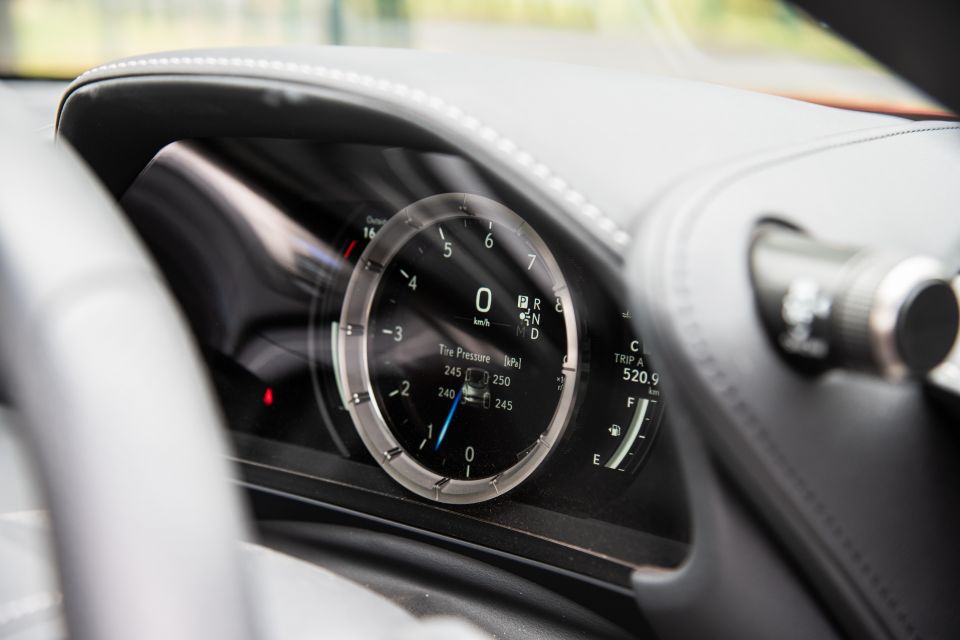
Where expert car reviews meet expert car buying – CarExpert gives you trusted advice, personalised service and real savings on your next new car.
The Lexus LC range is covered by a four-year/100,000-kilometre warranty.
Additionally, customers receive a three-year membership to the Lexus Encore owner program including capped-price servicing, 24/7 roadside assistance, and “invitations to exclusive dining and hotel partnership offers, and luxury lifestyle experiences”.
Scheduled maintenance is required every 12 months or 15,000km, whichever comes first. Under the Lexus Encore program, the first three visits for the LC cost $595, equalling $1785 over three years or 45,000km.
Other benefits include complimentary pick-up and return of the vehicle from home or work, a loan car, and exterior wash and interior vacuum.
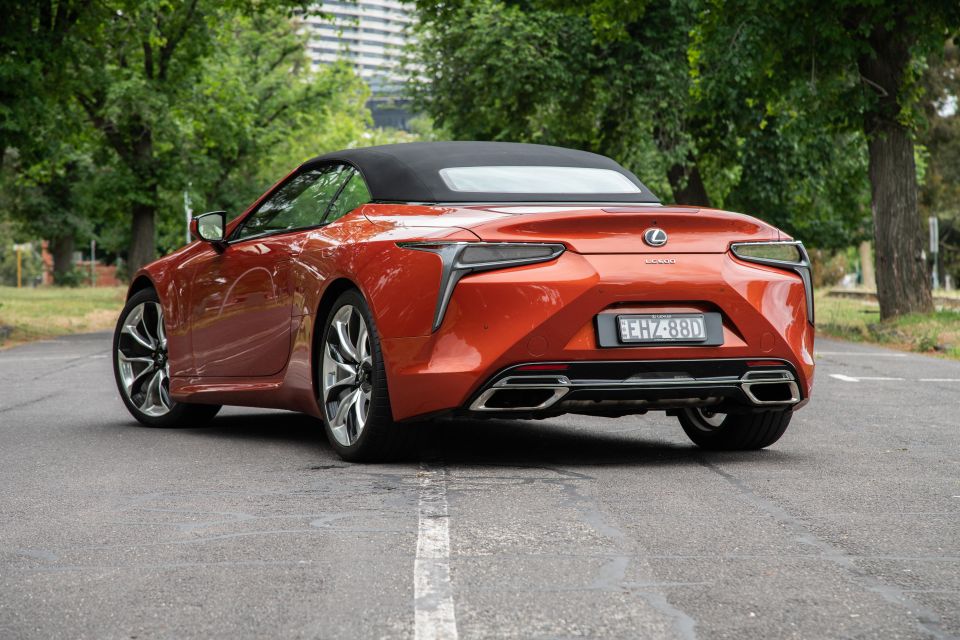
The LC500 Convertible is just one of those cars.
Often something is lost in translation when you turn a coupe into a convertible, but Lexus has improved the LC500 in the transition from hardtop to drop-top.
Although it’s not perfect, the LC500 Convertible is damn close to it. From the looks to the cabin, to the way that stunning V8 engine sounds, there’s not much more you could want from a luxury grand tourer.
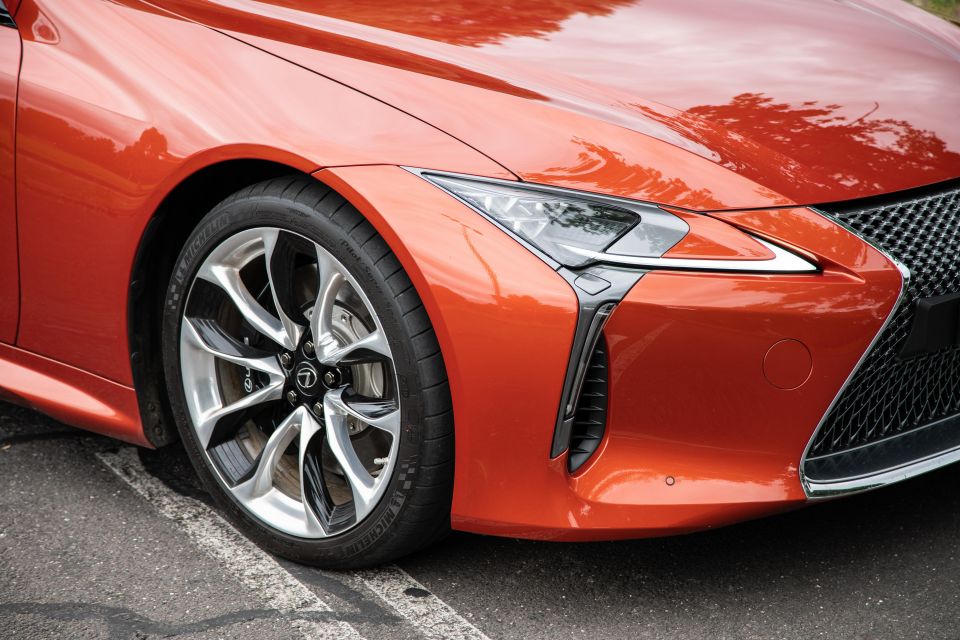
Click on the images for the full gallery
MORE: Lexus LC500 news and reviews MORE: Everything Lexus
Where expert car reviews meet expert car buying – CarExpert gives you trusted advice, personalised service and real savings on your next new car.
Scott Collie is an automotive journalist based in Melbourne, Australia. Scott studied journalism at RMIT University and, after a lifelong obsession with everything automotive, started covering the car industry shortly afterwards. He has a passion for travel, and is an avid Melbourne Demons supporter.


William Stopford
1 Day Ago


CarExpert.com.au
4 Days Ago


Derek Fung
8 Days Ago
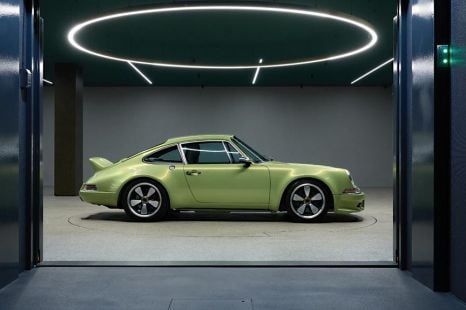

Marton Pettendy
24 Days Ago
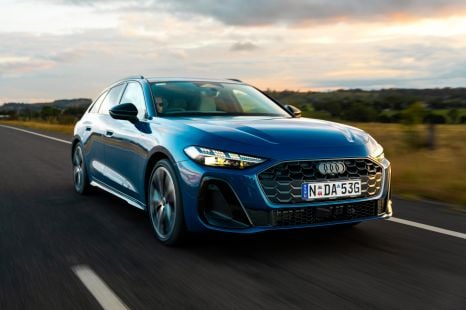

James Wong
1 Month Ago
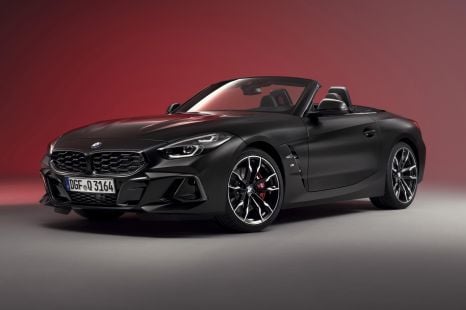

Damion Smy
1 Month Ago